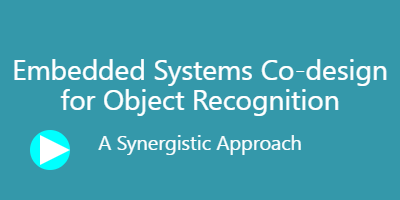Embedded Systems Co-design for Object Recognition: A Synergistic Approach

Introduction
Embedded systems co-design is a methodology that harmonizes hardware and software design from the outset of system development. It is crucial for developing high-performance and efficient solutions. Embedded systems co-design, exemplified by innovations like Tesla's self-driving cars, is playing a pivotal role in addressing the ever-evolving landscape of security concerns while enabling state-of-the-art object recognition. As the global surveillance camera market charts a course toward substantial growth, projected to reach USD 81.36 billion by 2030 with a remarkable CAGR of 10.7% from 2023 to 2030, and the security market in Canada experiences significant expansion, with an expected annual growth rate (CAGR 2022-2028) of 8.97%, resulting in a projected market volume of USD 613.8 million by 2028, this blog will provide a comprehensive exploration of the realm of embedded systems co-design for object recognition. It will shed light on the myriad benefits, challenges, and real-world applications of this dynamic field while also highlighting the latest trends and developments that are shaping the future of embedded systems co-design for object recognition.
Understanding Embedded Systems Co-design for Object Recognition
Embedded systems co-design incorporates a concurrent development of hardware and software components, understanding their interactions, and ensuring they complement each other to achieve optimal functionality, superior performance, and maximum power efficiency. Co-design for object recognition enables the creation of sophisticated systems by seamless integration of hardware accelerators, software algorithms, and optimized architectures. This makes them suitable for the real-time processing of images, accurate identification of objects, and efficient resource usage.
Components of Co-designed Systems
- Hardware Accelerators: To achieve real-time object recognition, dedicated computational hardware units like GPUs, FPGAs, and microprocessors are integrated into the system, offloading computationally intensive tasks from the CPU, enabling parallel processing and faster inference.
- Customized Neural Network Architectures: Co-design allows the creation of neural network architectures tailored to the hardware's capabilities. These architectures can leverage optimized layers and operations to maximize efficiency.
- Memory Hierarchy Optimization: Co-design considers memory access patterns, optimizing the memory hierarchy to minimize data movement and latency. Such optimization is crucial in systems with limited resources for maintaining real-time performance.
- Power Management: Efficient co-design incorporates power management strategies, such as dynamic voltage and frequency scaling, to balance system performance and power consumption.
- Software Optimization: Software algorithms must exploit the strengths of the hardware. Techniques like bit manipulation, model pruning, quantization, and kernel fusion reduce computational complexity and memory usage while improving power efficiency.
Benefits of Embedded Systems Co-design
- Enhanced Performance: Co-design tailors the system to the specific requirements of object recognition, maximizing processing speed and accuracy.
- Reduced Latency: Co-designed systems achieve lower inference latencies by minimizing data transfer between components and optimizing algorithms.
- Energy Efficiency: Hardware accelerators and optimized algorithms reduce power consumption, making the system more energy-efficient and extending battery life in mobile applications.
- Real-time Responsiveness: Co-design ensures that the system can meet real-time processing demands, which is crucial for applications like robotics and autonomous vehicles.
- Resource Optimization: Hardware-software collaboration prevents resource wastage, effectively harnessing the available computing power and memory.
Challenges and Considerations
- Design Complexity: Co-design involves intricate trade-offs and careful decision-making, demanding profound personnel expertise in hardware and software domains.
- Algorithm-Hardware Matching: A vital step is to select an efficient algorithm and neural network architecture that aligns with the hardware capabilities.
- Optimization Overhead: Optimization enhances performance but can also introduce overhead during design and implementation.
- Platform Heterogeneity: Co-designed systems must work across various platforms and devices, necessitating adaptable and scalable solutions.
Applications of Co-designed Object Recognition Systems
Co-designed object recognition systems are revolutionizing a wide array of industries, including retail, consumer electronics, security, industrial automation, healthcare, and transportation. For instance, Amazon Go stores employ co-designed systems for cashier-less shopping, driving the growth of cashier-less stores and transforming the retail landscape.
- Consumer Electronics: Co-designed systems power intelligent devices developed for recognizing gestures, faces, and objects in everyday settings such as appliances in smart homes.
- Smart Cameras: Co-designed systems enhance security and surveillance by recognizing objects of interest in real-time video streams.
- Industrial Automation: Factory robots equipped with co-designed object recognition systems identify, isolate, and manipulate objects in real-time with precision and accuracy. The increasing industrial automation of production and manufacturing steps require more adaptable machines.
- Medical Imaging: Healthcare sector benefits from embedded systems co-design, improving the accuracy and speed of object recognition in diagnostic procedures, wearable devices, and navigation and tracking.
- Autonomous Vehicles: Co-designed systems enable real-time object detection for advanced driver assistance systems (ADAS) and self-driving cars. Self-driving cars equipped with advanced safety technologies, such as LiDAR, radar, cameras, and utilize a myriad of sensors to provide features such as parking assistance, blind spot detection, adaptive cruise control, and more, experience notable advantages.
Conclusion
Embedded systems co-design for object recognition represent the synergy between hardware and software, resulting in systems that excel in performance, efficiency, and accuracy. By optimizing neural network architectures, hardware accelerators, memory hierarchies, and software algorithms, real-time object recognition helps in several diverse applications. As technology continues to evolve, the collaborative approach of co-design will play a pivotal role in shaping the future of intelligent, perceptive embedded systems.
- Comments
- Write a Comment Select to add a comment
To post reply to a comment, click on the 'reply' button attached to each comment. To post a new comment (not a reply to a comment) check out the 'Write a Comment' tab at the top of the comments.
Please login (on the right) if you already have an account on this platform.
Otherwise, please use this form to register (free) an join one of the largest online community for Electrical/Embedded/DSP/FPGA/ML engineers:























